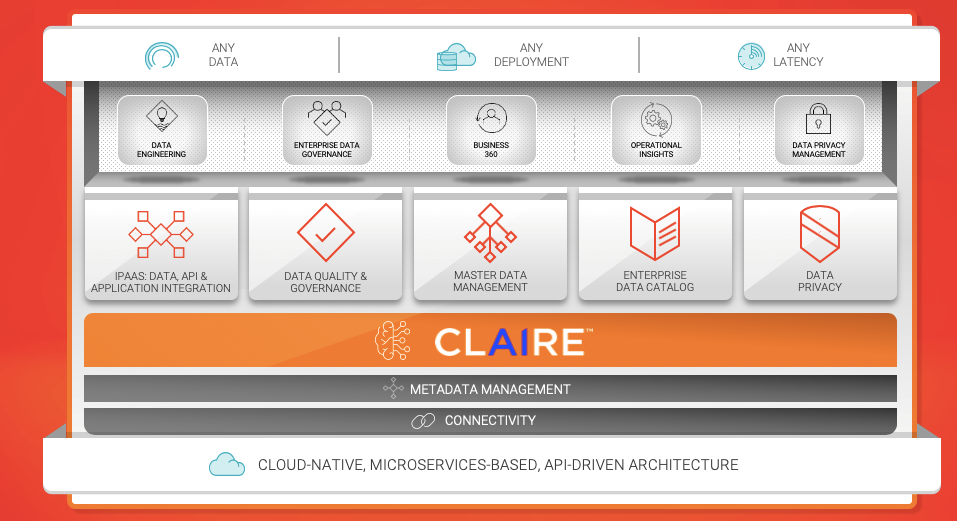Informatica’s Intelligent Data Platform Is Blockchain Glue – Delivering Interoperability at Scale!
Co-authored with Arsalan Sheikh, Cloud Integration Sales Specialist.
The following story is a fictional account to illustrate issues faced by typical executives. The names of people and companies are made up, but the challenges are real.

Lando Jacobs looked out the window from his office on the 32nd floor at the towering skyline of the business districts. He needed a moment to clear his head after the heated update from the project management and technical leads on his flagship blockchain project. Project Zen was complicated: maintaining end-to-end chain of custody for drugs and collecting sensitive PHI data had regulatory challenges, not to mention the added technical complexities. Bringing together data from public hospitals, private clinics, hundreds of pharmacies, health insurers, and patients onto a single immutable record stored in a blockchain was not easy.
When the project was conceived, it was thought the biggest challenge would be security. The team had overcome that by selecting a private permissioned blockchain that would allow access controls to define different participants, user roles, clear governance structures, and better performance and scalability. The ability to strictly control access to encrypted data based on user roles was particularly important since they would be dealing with private healthcare data.
Yet, six months into the planning phase they faced huge new risks. Two major public hospitals were not ready to connect through APIs and could only provide data through a batch export. Out of 250 pharmacy chains, 10 were ready to connect through a B2B gateway, 12 had the ability to stream data in through real-time replication, 78 could provide data through daily exports of CSV data, and the remaining 150 could only provide spreadsheets of data uploaded to a file server.

Project Zen was supposed to connect healthcare provider parties and patients to a single secure platform to improve both efficiencies and outcomes in the healthcare sector. When he started, Lando thought adopting a new blockchain platform and securing patient privacy would be the biggest challenge. But it seemed the diversity in stakeholders’ technology adoption and readiness to connect would delay the eight-month project at least another six months.
Blockchain Business Challenges
Although Project Zen is a hypothetical scenario, it is not far from the truth. As Christopher G. McDaniel president of the Institutes RiskBlock Alliance has said in this Accenture report, "The whole point of doing blockchain is it's a team sport." The distributed and decentralized nature of blockchain is forcing business to rethink their business models and completely disrupt their domain. Blockchain technology works and its impact on business is significant, but CXOs need to ask themselves:
- Do I have internal and external stakeholder buy-in for my use cases?
- How does blockchain impact my partner ecosystem?
- How can I leverage the decentralized and transparent nature of blockchain?
- What are the governance and compliance implications?
- How will I fill the skill gap?
The Deloitte 2019 Global Blockchain Survey outlines exactly these concerns. It is not a matter of whether blockchain will work, but rather what can you do with it.
If our imaginary CIO Lando Jacobs had focused on the ecosystem rather than internal development and processes, he could have directly linked the patient with supplier, maintaining an end-to-end chain of custody and a full lifecycle of the drug. With smart contracts, expired medication or sale without prescription will be automatically enforced. The analytical insights from this chain would be invaluable, insights like:
- Average time on shelf
- Real-time supply versus demand
- Stock levels
- Smart contracts enforcing drug expiration and prescription
- Medication expiration statistics
Blockchain Technical Challenges
Adopting blockchain will not be without its perils. While the concepts of decentralization and distribution are tempting, there are real-world constraints. Blockchain-native, born on the cloud companies are a greenfield operation and have the flexibility to use the latest and greatest. However, existing business adopting blockchain must consider:
- Interoperability- Integrating different blockchains to legacy applications remains a huge challenge.
- Standardization- The technology is still in its infancy and there are no standard models for integration, wallet formats, and consensus.
- Decentralized access rights management. - While transparency is key, how do we maintain confidentiality of PII, PCI, and PHI data on the chain?
- Data quality- In a decentralized environment how do we ensure data quality on the chain?
- Scalability- Traditional streaming applications can handle 60 million transactions per second. Blockchain is nowhere close to handling this kind of load.
Given these constrains, combined with lack of experienced resources, the technical impact of blockchain is significant. As advocated by this articlehere, tech teams need to use an agile, MVP (minimum viable product)-based approach to gradually infuse the technology in the existing technology landscape.
Blockchain Glue
Given the business and technology challenges, there is an inherent need for a glue that can bring all the stakeholders together, a glue that can stick together the different technologies and enable a seamless business flow. The Informatica Intelligent Data Platform is ideally suited to be that glue.

The same design patterns that Informatica pioneered during the data warehousing and ETL era are ideal for initializing the blockchain and extracting data from them for reporting.
The big data revolution brought scale to the data landscape and the Informatica Intelligent Data Platform adapted to handle the unique demands of Hadoop and Spark Streaming. Informatica emerged as the clear market leader in the big data landscape in late 2000s. The same design patterns were again leveraged to enable the cloud revolution and yet again the Informatica Intelligent Data Platform emerged as the clear market leader for cloud data warehouses and data lakes.
In December 2019, with its 10.4 release, Informatica released the tech preview of the Informatica Blockchain Connector. The connector enables legacy, big data, cloud, and blockchain applications to be connected through a unified platform. The Informatica platform offers the following unique capabilities:
- Codeless WYSIWYG integration
- 200-plus application-specific connectors
- Integrated and reusable data quality rules
- Comprehensive data security capabilities
- Improved productivity with AI-enabled tools
- Hybrid cloud deployment model

Conclusion
Lando Jacobs was feeling happy but not satisfied. In the past six months, his team had rallied their resources and it seemed they were on target to successfully complete the project. By making a timely investment in a data management platform, they had cut months of custom development and configurations, and managed to bring data from all their stakeholders into the national unified healthcare blockchain hub. They were able to export data from the trusted blockchain platform for analytics and reporting into their cloud data lake. They were able to run data quality checks to keep the data clean and consistent. They were even able to satisfy regulators that sound data governance was in place and give stakeholders a 360-degree view of patients and drugs.
With parties based on mobile, on-premises data centers, and cloud platforms, they had managed to link their data sources however they were able to provide it. Furthermore, a single data platform meant the team had been able to invest in minimum new staff and training resources to get the job done faster.
Next Steps
Contact us to learn more, or read the documentation overview of the Blockchain Connector.








